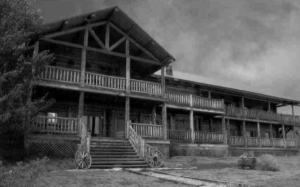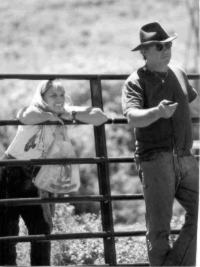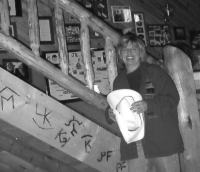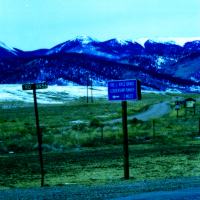Article by Gene Rybarczyk
Roadside attractions – April 2002 – Colorado Central Magazine
AS WE DROVE AWAY from the ranch I had a strong feeling that we had not been told the truth. I said as much to John and Colleen Weeks, my friends from Creede. John asked what I meant. I had to admit I wasn’t quite sure. It wasn’t that anyone had lied to
That ambiguous autumn morning found us in the foothills of the San Juans at the far north end of the San Luis Valley. The dirt track angled down across the slope. The great jagged wall of the Sangre De Cristos rose to the east. There was no snow yet. Though late October, it had been dry.

During the past few years I had been intrigued by a sign on US 285 just north of Villa Grove. It indicated the turnoff for the Braid Youth Leadership Ranch. My curiosity had smoldered for some time. Anyone who’s been through Villa Grove can plainly see that it’s in the middle of nowhere — magnificent as that nowhere might be. What kind of serious program, I wondered, could be operating several miles further out?
The thing was, it’s exactly the sort of location I would have chosen, but the ultra-light population density pretty much spoke to the popular wisdom of that idea. So who were these Braid Ranch folks and what were they up to?
I finally decided to find out. First I called the Weeks and asked if they were up for a small adventure. Then I called the ranch and asked if we could come by.
In 1994, Ken Braid was a partner in a successful construction material firm. His wife, Colleen, worked as a respiratory therapist. Originally from the Chicago area, they were living the good life in Florida. Both were smart, outgoing, pleasant people, graduates of the University of Illinois, with a large circle of friends.
Son Kyle, sixteen that year and their only child, was starting guard on the varsity football team. Like his parents, Kyle was successful and popular, and enjoyed an informal leadership role with his peers. Colleen and Ken took deep pleasure in their family life and its successes, but most of all they saw in their son the reward for their love and hard work.

That year, on the last day of February, Kyle killed himself. He left no note. Earlier in the day Kyle had bought tickets for a rock concert and later he talked with a friend, planning for an upcoming ski trip. There had been no remarkable changes in the six-foot-one sophomore’s behavior. But a couple of days after his death some of his friends revealed new information: Kyle had begun to experiment with anabolic steroids. The grim conclusion was that Kyle’s suicide was the result of the mood-altering effects of that drug.
Kyle’s act not only took his own life — it also brought an end to life as Colleen and Ken Braid knew it. In its place, as they laid their son to rest, was a deep pall of despair. The death of one’s child seems a betrayal by nature, and that of an only child a cruelly deliberate termination of dreams. But when it’s by his own hand, it opens a chasm of anger, doubt, and recrimination that can swallow hope and extinguish a marriage.

Ken and Colleen Braid dully faced the future.
Responding to their implacable grief, friends invited the Braids to their home near Colorado Springs, hoping the change of scene and their loving support would help ease the awful burden.
But the Braids remained restrained and distant. They took respite in their sorrowful affinity, alone together, spending much time absorbed in their own thoughts. Sleeping was difficult; awakening worse.
Then one morning less than two weeks after Kyle’s funeral, Ken suddenly came awake in the early morning dark. Turning to Colleen, he gently woke her and said, “I know what we have to do.”
Within three months the J. Kyle Braid Youth Leadership Foundation had been incorporated. Ken and Colleen began liquidating personal assets and transferring the funds to the non-profit foundation. The burst of intense activity — planning, organizing, recruiting and finding just the right spot for the ranch — became the catalyst which helped the Braids turn their overwhelming grief into a living memorial for their son.
By 2001, more than 800 high school students had graduated from the two-year leadership program.

More than 40 high schools from across the country participate. Every year each school selects one or two pairs of sophomores from a group of nominees, students who already display the wit, wisdom and empathy of peer leadership. Nominated students must make formal application, including a mission statement, a proposal which includes both the student’s personal goals as well as defining a project benefiting school or community.
SELECTED STUDENTS spend one summer week at the ranch in an intensive leadership training program. Then they take their newly honed skills back to their schools for further development and to complete their mission statements. Ken and Colleen spend the summer supervising the ranch curriculum and the rest of the year visiting the schools.
But the ranch, and the training provided there, is the heart of the program. It’s not a fancy place. The buildings, while solid, functional and pleasant, are not luxurious. Nor is it for rich kids. There is scholarship money and each local school organization is asked to contribute to the costs.
But it is clever. Most notably, the Braids realized there was a need, and an opportunity, among kids who, like their son, demonstrated leadership ability. The need was to help those kids — often overlooked in the routine of deficit-based services — discover how to successfully weather the storms of adolescence. The opportunity comes into play by showing these kids how to model those skills and teach them to their peers, taking remarkable advantage of their leadership roles. Essentially, it takes the special abilities of a few kids and turns them to the advantage of their community.
Beyond the basic notion of the program, however, is the Braid’s execution of it. Their special style first came to my attention when Colleen Weeks asked Colleen Braid (yeah, I know, what were the chances?) about the brands burnt into the stringer board of the stairs in the main lodge dining hall.
She explained that, during construction, she and Ken realized many local folks had no idea what they were building, the most common guess being “a rich kids camp.” The Braids decided to hold a reception for the whole neighborhood, which in that part of the San Luis Valley includes pretty much everyone within field artillery range. And in a stroke of their own special genius, they invited the ranchers to bring along their branding irons, cementing a bond between locals and newcomers. Now the brands are a novel display for the kids, many of whom have no inkling of life in the wild and woolly west (most of the schools are in urban areas).
OTHER DEFT EXAMPLES of the Braid style soon came to light: an elaborate prank that turns into a non-threatening object lesson for each summer class; a new program devoted to improving high-school coaches’ communication skills; the involvement of local residents, including the sheriff and a state wildlife officer, as volunteer trainers. There was a string of serendipitous solutions to thorny situations. The Braids seemed to have a real talent for this.
We were impressed as Colleen Braid explained the program to us. In fact, one of my former lives had been spent in do-gooder work, and in Florida I’d held a state position which included the inspection and evaluation of adolescent programs. Even earlier, while in the graduate counseling program at Adams State, I had worked for an outfit called the Alamosa County Youth Services Bureau, which was recognized at the time as a statewide model program. So I knew when to be impressed, and at the Braid Ranch I was.
Days later, though, I stared at a blinking cursor.

Remembering Colleen Braid’s reserved smile, I struggled again to define what I had witnessed. Leaving the blank screen I went out on the porch to stare at the mountains enclosing South Fork. The late autumn aspen smudged the conifers muddy green weave. Rust cliffs tattered the fabric. The chill breeze, always present at this junction of two mountain canyons, whisked away the sun’s warmth. A magpie glided to a fence post. And a word took form: transcendence.
That’s what I’d missed. Because the program was so remarkable it had distracted me from something even more extraordinary: the transcendence of Ken and Colleen Braid.
These two, plunged into a horrific crucible, had more than just survived. They had bowed to the incineration of their lives and allowed that terrible energy to carry them beyond themselves. The Braids had emerged from the fire, not simply intact, but transformed.
From pursuers of the American dream they had became, together, creators of hope. Life as the Braids once knew it had ended, but a remarkable course had presented itself, and a new life emerged. In that transcendence they have found, perhaps, their highest and best use.
Gene Rybarczyk launches small adventures in the San Luis Valley from his base camp in South Fork.

